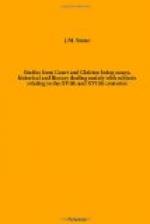Wriothesley, in forwarding this letter from the queen, Lord Parr’s “gracious lady and kind sister,” doubts not but that he will thank God, and frame himself to be more and more an ornament to Her Majesty.
The marriage was in every way satisfactory. Katharine was twenty-six, about one year younger than the Lady Mary, and was by universal fame reported “a prudent, beautiful, and virtuous lady.” The royal family had reason to be grateful for her influence over the king, whom she persuaded to restore both Mary and Elizabeth to their rank. To Edward she was a second mother, and Henry seems to have looked upon her with something akin to respect, appointing her regent when he crossed the Channel to invade France in 1544.
She offended him, however, on one occasion, by venturing to express a difference of opinion on a religious question, and it was said that articles of heresy were drawn up against her. “A good hearing it is,” exclaimed Henry, “when women become such clerks; and a thing much to my comfort to come in mine old days to be taught by my wife! Her prudence and tact saved her life, if it was ever seriously in danger.”
Henry’s sordid tragedy was played out on the 28th January 1547, when the tyrant breathed his last, and left his two wives and two daughters to unravel the skein which he had so persistently entangled for them. Katharine Parr took her fate immediately into her own hands, and thirty-five days after Henry’s death, secretly married her former admirer, Sir Thomas, now Lord Seymour, who was described by Hayward as “fierce in courage, courtly in fashion, in personage stately, in voice magnificent, but somewhat empty in matter.” The union was not a happy one, owing mainly to Seymour’s intrigues with the Princess Elizabeth, a circumstance that was thought to have shortened Katharine’s life. The ci-devant queen died at Sudeley Castle, after having given birth to a daughter, in August 1548, aged thirty-six.
After the one tragic episode in her life, the course of Anne of Cleves ran smoothly enough. Mary befriended her always, and made her quondam stepmother a prominent figure at her coronation. She frequently paid her visits, and treated her with all the respect imaginable. Anne never left England after her ill-starred arrival, ending her days peacefully in 1557.
III. A NOTABLE ENGLISHMAN
While Edward’s Council thought that they had effectually closed every issue through which news of the king’s death might transpire, before their seditious plans were completed, the Princess Mary was already on her way into Norfolk, calling all loyal men and true to rally round her standard. Two Norfolk gentlemen were mainly instrumental in placing her on the throne. These were Sir Henry Jerningham and the subject of this memoir, Sir Henry Bedingfeld of Oxburgh, who came in to her assistance at Framlingham, with 140 well-armed men.




